With the push to move away from fossil fuels, sustainable heating solutions are more important than ever. One emerging technology leading the way is the ground source heat pump.
In this guide, we’ll explore how ground source heat pumps work, their benefits, and whether they’re the right choice for your home.
What is a Ground Source Heat Pump?
A ground source heat pump (or GSHP for short) is an energy-efficient heating system that harnesses the natural heat from the ground to both heat your home and provide hot water.
Unlike traditional boilers that burn fossil fuels, GSHPs use a network of underground pipes to extract the stored solar heat energy from the earth. At 1m depth, the ground temperature sits at a pretty constant 12°c
This makes them a very sustainable and cost-effective alternative to gas, oil, or electric heating systems.
Even in winter, the ground beneath the surface maintains a constant temperature. A GSHP works by circulating a mixture of water and antifreeze through buried pipes, absorbing this natural heat.
The system then compresses and transfers the heat to your home’s central heating or hot water system. As a result, you get reliable heating with lower carbon emissions and, in some cases, significantly reduced energy bills.
Ground source heat pumps are ideal for well-insulated homes and work particularly well with underfloor heating or low-temperature radiators.
While the upfront installation costs can be significantly higher than conventional heating systems, homeowners can benefit from government incentives, long-term savings, and increased energy efficiency.
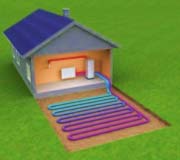
Diagram of a ground source heat pump system showing pipework
How Do Ground Source Heat Pumps Work?
Ground source heat pumps (GSHPs) use underground pipes, known as a “ground loop,” to extract heat from the earth.
This renewable energy source provides efficient home heating and hot water while reducing reliance on fossil fuels.
The pipes are typically buried horizontally for cost-effectiveness, but if space is limited, they can be installed vertically in deep boreholes.
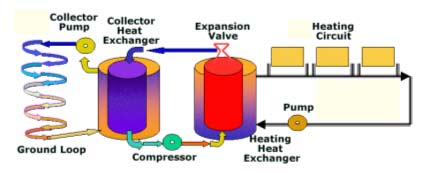
Diagram of a ground source heat pump system showing all components
In terms of how a ground source heat pump system works to heat your home, it’s mostly as follows:
- A water-antifreeze mixture circulates through the ground loop of the system, absorbing the natural heat from the soil.
- This warmed fluid passes through a heat exchanger, transferring its heat to a refrigerant.
- The refrigerant is compressed, raising its temperature to provide heating and hot water.
- The cooled fluid then returns underground to re-absorb more heat, repeating the process.
- Ground loop length varies based on home size and heating the demand required. Essentially, the longer loops extract more heat but on the downside do require more space.
Other heat pump types use similar technology but different heat sources:
- Air Source Heat Pumps: Extract heat from outdoor air, making them a space-saving and cost-effective alternative.
- Water Source Heat Pumps: Use heat from lakes or rivers, offering efficient heating where water sources are available.
- MVHR (Mechanical Ventilation and Heat Recovery): Captures and reuses heat from ventilated air, ideal for well-insulated homes.
Types of Ground Source Heating Systems
Ground source heat pumps (GSHPs) are a highly efficient and eco-friendly way to heat homes by harnessing the earth’s natural warmth. These systems provide a reliable alternative to traditional heating, reducing energy bills and carbon emissions.
Different types of GSHPs suit different properties and installations. Here are the most common options:
Closed-Loop Ground Source Heat Pump Systems
Closed-loop systems are the most widely used type of ground source heat pump, circulating a water-antifreeze mixture through buried pipes to absorb and transfer heat. These systems can be installed in three main ways:
Horizontal Closed-Loop
Best suited for properties with ample outdoor space, this system places pipes in shallow trenches (typically 4 to 6 feet deep). It’s a cost-effective choice but requires significant land area, making it ideal for rural homes.
Vertical Closed-Loop
Ideal for properties with limited ground space, vertical systems use boreholes (100 to 400 feet deep) to house the pipes. While installation is more expensive, these systems are highly efficient and minimise landscape disruption.
Pond/Lake Closed-Loop
If a property has access to a suitable water source, pipes can be submerged in a pond or lake where stable temperatures enhance efficiency. This method requires less excavation, making it a cost-effective solution—provided the water body meets the necessary criteria.
Open-Loop Ground Source Heat Pump Systems
Unlike closed-loop systems, open-loop systems use groundwater or surface water directly. Water is drawn from a well, lake, or pond, absorbs or releases heat, and is then returned to its source.
These systems are highly efficient since water conducts heat well. However, they require a consistent, clean water supply and must comply with local environmental regulations.
If your property has a reliable water source, an open-loop system can be a cost-effective alternative to closed-loop options, provided the supply remains sustainable.
Hybrid Ground Source Heat Pump Systems
Hybrid systems combine a ground source heat pump with other energy sources, such as a boiler or solar thermal panels, to improve efficiency and flexibility.
This approach reduces energy consumption and adapts well to seasonal temperature changes. Customisable to specific needs, hybrid systems can lower both installation costs and long-term energy bills.
Do You Need Planning Permission for a Ground Source Heat Pump?
In most cases, installing a ground source heat pump (GSHP) in the UK does not require planning permission, as it falls under permitted development rights.
However, there are some exceptions, and it’s always best to check with your local authority planning office before starting any form of installation.
When Planning Permission May Be Required
- Listed Buildings & Conservation Areas – If your property is a listed building, in a conservation area, or an Area of Outstanding Natural Beauty (AONB), you may need approval to ensure the system does not impact the surroundings.
- Large-Scale Installations – If the system is intended for a commercial property or a large multi-unit development, planning permission may be required.
- Depth and Excavation – Some councils may impose restrictions on deep boreholes or extensive groundworks, particularly if they affect local water tables or ecosystems.
How to Check if You Need Permission
To ensure compliance, contact your local planning department or use the UK Planning Portal to check specific regulations for your area. If required, you may need to submit a planning application detailing the proposed installation.
While most homeowners won’t need planning permission, confirming beforehand can prevent delays and additional costs. If permission is required, your installer or a planning consultant can help guide you through the application process.
Ground Source Heat Pump Alternatives
While ground source heat pumps (GSHPs) are an efficient way to heat your home, they are not always practical for every property. If space, cost, or installation challenges make a GSHP unsuitable, there are several alternative renewable heating options to consider.
1. Air Source Heat Pumps (ASHPs)
Air source heat pumps work similarly to GSHPs but extract heat from the outside air instead of the ground. They are cheaper and easier to install, making them a popular alternative, especially in urban areas where ground excavation isn’t possible. Modern ASHPs can operate efficiently even in colder UK temperatures.
2. Water Source Heat Pumps (WSHPs)
If your property is near a river, lake, or large pond, a water source heat pump can be a highly efficient alternative. These systems transfer heat from the water, offering excellent performance due to the stable temperatures found in bodies of water. However, they require access to a reliable water source and may need environmental permissions.
3. Biomass Boilers
Biomass boilers use organic materials such as wood pellets, logs, or chips to generate heat. They are a sustainable alternative, particularly for rural homes with access to cheap or free wood fuel. However, they require storage space for fuel and regular maintenance.
4. Solar Thermal Systems
Solar thermal panels use the sun’s energy to heat water, which can be used for central heating and hot water systems. While they work well in combination with other heating sources, their effectiveness depends on sunlight availability, making them less reliable as a sole heating solution in the UK.
5. Hybrid Heating Systems
Hybrid systems combine different technologies, such as an ASHP with a traditional boiler, to improve efficiency and reduce reliance on fossil fuels. These setups offer flexibility, allowing homes to benefit from renewable energy while ensuring a backup heating source during extreme cold spells.
Benefits of Ground Source Heat Pumps
Ground source heat pumps (GSHPs) offer significant energy savings, potentially cutting heating costs by many hundreds of pounds per year, depending on your current system.
Although government incentives like the Renewable Heat Premium Payment have ended, GSHPs still provide long-term financial and environmental benefits, including:
- Lower Carbon Emissions: By using renewable heat from the ground, GSHPs reduce reliance on fossil fuels and cut CO₂ output.
- No Fuel Deliveries: Unlike oil or LPG heating, GSHPs run on electricity, eliminating the need for fuel storage or deliveries.
- No Boiler Required: GSHPs provide consistent heating without the need for a traditional boiler to boost hot water.
- Minimal Maintenance: Designed for long-term reliability, GSHPs require little maintenance compared to conventional heating systems.
With rising energy costs and a shift towards sustainable heating, GSHPs are a smart investment for homeowners looking to reduce bills and improve efficiency.
Choosing the right alternative depends on your property size, location, budget, and heating needs.
Consulting a professional can help you determine the best solution for your home while maximising energy efficiency and cost savings.
Ground Source Heat Pumps – Maximise Your Savings
To maximise savings with your ground source heat pump, consider the following:
- Efficient Heat Distribution: Underfloor heating works better than radiators, as it uses lower temperatures and covers a larger area.
- Existing Heating System: The less efficient your current system, the more you’ll save with a heat pump.
- Hot Water Usage: Heat pumps may be less efficient for hot water. To boost performance, consider adding a solar thermal system for warmer months.
- System Usage: Heat pumps are more cost-effective when running consistently. You can keep the thermostat lower while maintaining comfort due to the steady heat.
Installing a ground source heat pump is a great way to cut heating costs and reduce your environmental impact while enjoying noticeable savings.
Ground Source Heat Pump Installation Time
When considering a ground source heat pump for your home, one important factor to consider is the installation time.
While the process can take a bit longer than traditional heating systems, the benefits far outweigh the wait.
On average, installing a ground source heat pump can take between 7 to 10 days, though this can vary depending on the complexity of the system and the size of your property.
The installation starts with an assessment of the property, where the suitability for ground loop is determined. If opting for a horizontal closed-loop system, digging required trenches 1 to 2 metres deep, can take several days to complete.
In contrast, a vertical system requires drilling boreholes, which is more labour-intensive but takes less space. This can take anywhere from 1 to 3 days, depending on the depth required.
Once the ground loop is in place, the heat pump unit inside your property is installed. This typically takes 2 to 3 days and includes connecting the system to your home’s heating and hot water systems.
Additionally, plumbing, electrical connections, and testing are also completed at this stage to ensure everything works properly.
It’s also essential to plan for any landscaping or ground restoration after the installation of the ground loops, which may add a few more days to the overall timeline.
To avoid delays, it’s crucial to hire an MCS-accredited installer with experience in ground source heat pump installation. This ensures that the system is correctly sized and installed to maximise efficiency.
Ground Source Heat Pump Installers
To qualify for any type of government incentive like the Renewable Heat Incentive and Renewable Heat Premium Payment (both unfortunately ended for new applications now), you have to ensure your installer is MCS accredited.
Only MCS-certified installers are the only installers that can validate installations for these schemes and ensure that the system installed is sized and installed correctly.
Ground Source Heat Pump Costs
As good and efficient as ground source heat pumps can be, it’s important to consider the initial installation costs before you take the plunge as these can be significant!
The total cost of installing a ground source heat pump in the UK typically ranges from anything between £8,000 to £49,000.
The main factors on the cost come from things like the size of your property, the type of system being installed and the complexity of the installation itself.
For example a horizontal closed-loop system is typically the most cost-effective, as it requires digging long trenches over a wide area. A system of this type can cost between £8,000 and £30,000.
If you have limited space, a vertical closed-loop system may be more suitable, but it comes at a higher price, typically between £12,000 and £49,000 due to the need for drilling boreholes.
Additionally, if you have access to a nearby water source, a pond or lake closed, a loop system may offer a more affordable alternative, generally costing between £10,000 and £25,000.
Installation costs can also vary depending on the region, the experience of the installer, and the overall site conditions. For example, if your property requires significant landscaping or excavation work, this could increase the price quite a bit.
It’s essential to obtain quotes from multiple MCS-accredited installers to ensure competitive pricing and proper system sizing for maximum efficiency. Keep in mind that while ground source heat pumps come with a hefty upfront cost, they offer long-term savings on energy bills and require minimal maintenance (although some is required), making them a solid investment in the future.
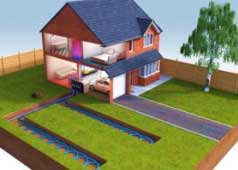
Diagram of ground source heating system pipework and its connection to the boiler
Ground Source Heat Pump Installation Checklist
For a smooth installation, consider the following key factors:
- Ground Loop Space: Ensure enough land for a horizontal loop. If space is tight, a borehole system may be needed for a vertical system, but check for machinery access.
- Home Insulation: Well-insulated homes retain heat better, making the pump more efficient. Proper draught-proofing and insulation is essential.
- Current Heating System: Homes using electric, solid fuel, or oil heating see the biggest savings. Gas-heated homes may benefit less.
- Heat Distribution: Underfloor heating, larger radiators, or low-temperature fan convectors work best with heat pumps.
- Planned Renovations: If you’re already doing home improvements, combining projects can cut costs.
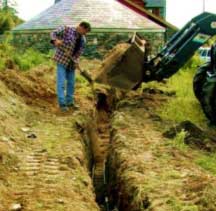
Trench with ground source heating pipes being filled
Heat pump efficiency is measured by the Coefficient of Performance (CoP), showing how much heat is generated per unit of electricity. Higher CoP means better efficiency, with top models delivering up to 4 kW of heat per 1 kW of electricity.
The System Efficiency Ratio (SER) reflects the overall system performance, typically ranging from 1 to 4. Ground source heat pumps average 2.3 – 2.5, with the best reaching 3.3 for maximum savings.
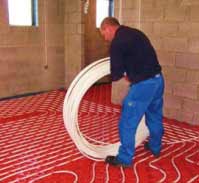
Underfloor heating system pipework being installed
How to Install a Ground Source Heat Pump
The process of installing a ground source heat pump is very complex and will vary depending on the type of installation, the installation location, the installer, ground conditions and several other factors, so it’s really not possible to give a definitive run down on the process.
However in most cases the process should cover most of the following stages:
Step 1: Site Assessment and Planning
Before any installation takes place, a professional will assess your property to determine if a GSHP is suitable.
Key factors include available land, soil type, insulate properties of property and heating requirements. If space allows, a horizontal ground loop can be installed, while smaller properties may require vertical boreholes.
Step 2: Ground Loop Installation
Firstly, the trenches or bore holes are dug or bored down through the ground and then the ground loop, the series of pipes that extract heat from the ground, are installed based on your site conditions:
- Horizontal System: Pipes are laid in trenches around 1–2 metres deep, requiring a large open area.
- Vertical Boreholes: If space is limited, boreholes up to 150 metres deep are drilled to accommodate the pipework.
As an example, for a standard home and a horizontal system, roughly 600 feet of pipe will be used. A typical setup for a 2-bedroom house requires two trenches, each about 12 inches wide and 45 meters long, spaced 5 meters apart. Trenches should be level and in moist soil for better heat conduction.
Step 3: Heat Pump Unit Installation
The heat pump itself is then installed inside your home, once all of the pipework has been installed, typically in a utility room or plant room. Again, this will require a little space.
The pump and system is then connected to the ground loop pipes and this then transfers heat into your heating system.
As we have said, this works best with underfloor heating or large radiators.
Step 4: Connecting to the Heating System
The GSHP is integrated with your home’s heating and hot water system.
A buffer tank may be installed to optimise efficiency, and controls are set up to regulate temperature.
During this process, if you choose to increase the efficiency of the system, you may also have underfloor heating or larger radiators installed. This is a good move as it will make the system as a whole more efficient.
Step 5: Testing and Commissioning
Once everything is installed correctly, the system is fully tested to ensure proper and efficient operation.
Engineers check flow rates, pressure levels, and heat output before final adjustments are made.
Step 6: Ongoing Maintenance
Ground source heat pumps require minimal maintenance, but do require some.
Regular checks on filters, antifreeze levels, and system pressure will keep it running efficiently for 20+ years.

Ground source heating pipes installed in a trench
If you have a fairly well insulated home and a decent bit of land surrounding it then the decision to go for a ground source heat pump system to run your heating and hot water is arguably a good one to make as, after the initial outlay, they are fairly cheap to run, requite minimal maintenance and can last for many years.

